What's next for (and behind) Culture Cross
Videos, Podcasts, and Essays to bring you to Ancient Greece through Italy!
I’m incredibly excited to announce that I will be travelling to southern Italy in May 2024! I’ll split my time evenly between: 1) Naples and its surrounding bay and 2) the east coast of Sicily with a focus on Syracuse. I will be researching for future essays, creating short video documentaries, and crafting audio guides and podcasts.
I also want to take a moment to speak about my personal vision and mission behind this project I’ve entitled Culture Cross. Why? Read on!
The southern stretches of the Italian peninsula and the island of Sicily were key arenas for many events of ancient Greek civilization, and have played integral parts in the development of Roman society. Perhaps most importantly, from antiquity until today the region continues to provide crucial touchstones for understanding the ancient past – from the ongoing decryption of the world’s only Greco-Roman library to the evocative ruins of Pompeii.
I have been hard at work planning my itinerary, so this month’s post will be lighter on analysis and heavier on expectations. Instead of a deep dive into a small nugget of ancient history, let’s take stock of Culture Cross’ creations thus far, why I write here, and get a peek into what I plan to create over the rest of 2024!

Photographing History
The Italian trip will provide an opportunity for me to do in-person research of places, of objects, and of the geography which shaped the course of world history. The city of Naples (Νεάπολις or “New City” in Ancient Greek) and the bay around it contain millennia of Greek culture. It was the first Greek region the Romans conquered and thus became the growing empire’s primary point of contact — and obsession — with Greek tendencies in politics, art, and religion.
If you are a regular reader of my work, you may have noticed I use many of my own photos to help illustrate features and places mentioned in my writing. I always prefer to use my own photos, and so I’m particularly excited to visit the National Archaeological Museum of Naples to examine and photograph the frescoes, mosaics, and busts of countless important people (historical and mythological). I can use these photos whenever I refer to one of these people, such as the most famous portrait of Alexander the Great, which was found in the House of the Faun in Pompeii.
While creating an inventory of the images I most desire to see, a nagging curiosity has already sparked. My driving research question on Culture Cross is “How do we know what the ancient Greeks said?”, but in a future essay I intend to focus on imagery to explore the question “How do we know what the ancient Greeks looked like?”. Our sense of what Plato or Hercules/Herakles looked like, for example, is in large part driven by collections such as Naples’ archaeological museum. That collection is developed from the extraordinary remains of the Roman cities of Pompeii and Herculaneum, which were destroyed by the volcano Vesuvius (which still contain their own treasures I’ll visit).
Underwater, there are further ruins still. To the west of Naples is a town called Baia, which was a Roman resort town in the same bay as Rome’s early primary harbour. Most people have heard of Vesuvius, but on the other side of Naples is a huge volcanic caldera called the Phlegraean Fields. Half of Baia remains above water, while the other half of the city is submerged under the modern harbour from the tectonic activity of the nearby caldera. As a divemaster scuba diver, I’m particularly excited to explore history in the underwater ruins of Baia.
What’s behind Culture Cross?
To explain the other projects I will work on through my time in Italy, I want to first explain more about my original vision and mission behind developing Culture Cross.
A catalyst for launching Culture Cross was to have a venue within which I could develop my own knowledge and skills. As I wrote before, I am actually an amateur of the ‘Classics’. Outside this project, my professional and academic interests lay in anthropological research, the cultural environment of the Himalayan mountains, and tourism.
Indeed, my previous trip to Italy took me to the island of Sardinia alongside my professor, Dr. Sabina Magliocco, who in the 1980s had documented the processes by which the globalizing economy had laid bare the economic vitality and cultural lifeways of a rural Mediterranean village. During our visit to the same village in 2019, I conducted research on how Heritage Tourism is standing in as a lifeline for both the traditions of old and for the survival of the village writ large.
“Here’s the situation. Industry is gone, the agro-pastoral industry is practically gone as well. These small towns are depopulated. They’re economically poor. There aren’t many opportunities for people to work here, so there’s a lot of talk, a lot of big talk, about exploiting cultural heritage for touristic purposes – for economic purposes. There’s people who have conferences on this, they write articles about it, they write books about it. Everyone says we need to develop tourism.” - Excerpt from an interview I conducted with Gavino Cabras, a former mayor of Bessude, Sardinia
I also spent six months along a Hindu pilgrimage route in the Indian Himalayas studying how the specific method of travel along the multi-day mountainous journey had profound impacts on a yatri’s (pilgrim/traveller) experiences of both nature and the divine.
I met many travellers during my research, some of whom were explicitly travelling for the religious purpose of visiting the gods in their high mountain homes, and others for more secular, touristic purposes of enjoying the environment of the highest mountain range in the world. Nevertheless, each person was aware of the mythological and sacred stories related to the four deities whose temples make up the “Char Dham” (Four Abodes) circuit (Yamuna, Ganga, Shiva, and Vishnu) as they travelled through the alpine villages of the route.
Although Indian villages face the same issues of rural depopulation and economic decline as Italy and many other places, the Indian rural areas are still healthier than those I visited in Sardinia. When the snow began to fall and the temple pandats were getting ready to shut the doors for the winter before they became buried entirely, I was staying in one village along the route. The villagers were kicking off a 14-day theatre festival to tell the ancient story of the Ramayana, in which an avatar of Vishnu, Rama, chases down and defeats the demon king, Ravana.
All actors in the play hailed from the village, the stage and its effects were created and placed in the village square by the inhabitants, and — aside from a few of the yatris who stopped by and, well, me — the audience was made up of excited children and parents from just around the corner. It was incredible to witness the vitality of an ancient tradition carried by just a remote village, which has tourism but also continues its own heritage irrespective of the travel industry.
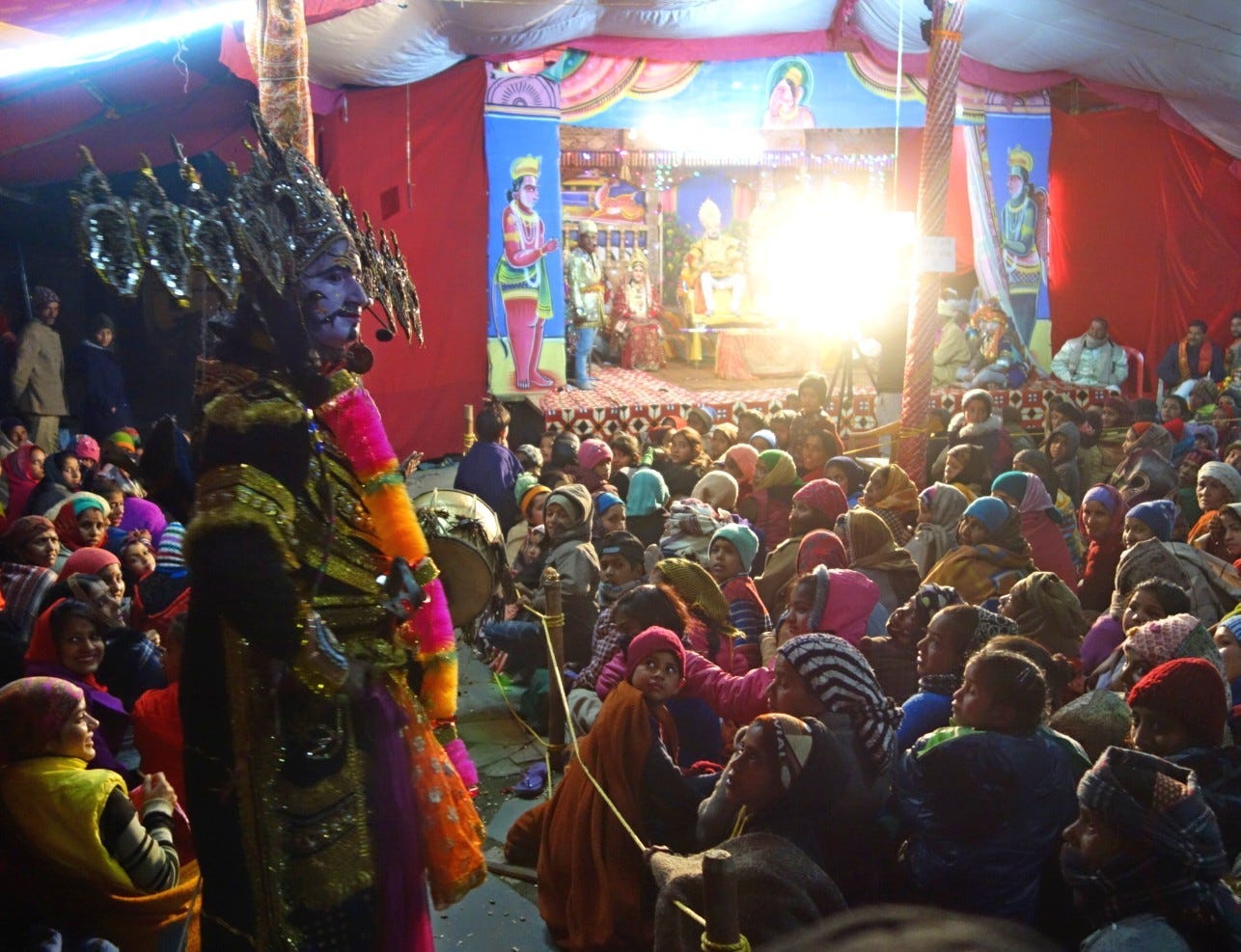
It was also fascinating to witness a tradition so different from the normative one I had known growing up in Canada with a European-inflected background.
But what is the normative tradition in Canada and the ‘West’?
There seems to be a misplaced assumption that a quick reference to Democracy or to Plato or a passage from the Bible would be understood by the common ‘Westerner’ just because European and American societies were built by those who apparently did know the basis of those older traditions. It was always strange to first learn about *insert-Western-canon-tradition-here* while reading about Hindu cosmology or Buddhist philosophy, because apparently simply being literate in English means that one must have a suitcase full of Greco-Roman-Judaeo-Christian baggage! I would think to myself ‘….actually, that might be the first time I’ve heard of that’.
Then a pandemic hit, and travel beyond our own walls was prohibited. The pandemic, being just one issue of many plaguing the modern world, got me to thinking. I couldn’t shake my personal feeling of disconnection with the touchstones of culture that have permeated through the past millennia of ‘Western’ and now global history. In a world with an uncertain future, is it beneficial to be marooned out in a drifting present, mindlessly trying to un-tether ourselves from whatever came before us? I don’t think so. To understand the world I inhabit, which was built by countless who came before me, I feel the need to comprehend the world as they saw it. Not to slavishly copy tradition, but if I want to set out in a new direction I would rather gain a head start by leaping from the shoulders of giants than putting a blindfold on and crawling about and simply feeling for the right path.
In 2022 I went to Greece and completed my Divemaster training. Along the way I visited amazing sites with inestimable pedigrees of history, and was faced with so many bald historical claims about exactly who said what and how events had unfolded in that particular place, that I just had to start my exploration of European history with the question: “How do we know what the ancient Greeks said?”
So I launched Culture Cross.
My mission is to bring together my global experiences in anthropology and heritage tourism with a growing knowledge of the traditions, heritage, and intellectual lineage of Europe and beyond. I want to create materials that cultivate a connection with what and who came before us, how that shaped us, and instill a sense of curiosity of what remains possible. I have a vision of taking this mission beyond the online written word and to embodied experiences of histories, landscapes, and cultures the world over.
It’s grand, profound, and maybe pretentious. But it’s fun to have a goal, and if I don’t succeed, I’ll have a stellar time in Italy taking some great pictures and sharing my research with all of you. Thank you for divulging my digression.
Read on if you’re interested in the videos and audio guides I intend to create (or just to read about some amazing history from Syracuse, Sicily).
VIDEOS COMING SOON
Beyond this quest for new but classical knowledge, I wanted to improve my ability to create. Not just writing words, but graphics, illustrations, maps, charts, sounds, and lights that can create a full-blown learning experience.
I have been dabbling in database analysis to improve my ability to conduct in-depth quantitative research – both of Humanities and elsewhere. One of my early attempts at analyzing a dataset came through my exploration of where the world’s Greek manuscripts are, and what proportion of those manuscripts are concerned with ‘Christian’ subjects, and which are on ‘Profane’ topics, such as the history or mathematics from which so much of Western knowledge and culture has been generated.
I also taught myself how to create and manipulate vector graphics so I could make images to compel and to explain.
Aesthetically, I’m most proud of the thumbnail for my post about the sacred Greek city of Delphi.
Functionally, I’m most proud of the charts and images I created for a How-To Guide on reading the different historical layers of an ancient Greek manuscript (this is also the most popular essay on Culture Cross, with a lot of traffic coming through Google image searches).
I was also invited by
to write a guest post for the Classical Futurist, which I entitled “The Threatened Survival of Ancient Texts”. In that essay, I created a timeline to show the truly staggering gaps — centuries or more — between the original writing of the ancient texts we hear so much about, and the actual oldest material copies of those texts. Worryingly, it is far from guaranteed that ancient works will survive with humanity into the future.I am now nervous — but also excited — to move beyond still images and graphics; that is, to try my hand at video.
Keen readers may have noticed that my two most recent essays were already about objects held at sites in the Bay of Naples. Those essays were background research that has gone into scripts that I wrote for two upcoming videos which I intend to shoot on location in Italy. The videos will explore locations and visual features related to the fascinating objects at the centre of the essays.
In February I published an essay on the ancient papyri scrolls of Herculaneum and what their groundbreaking decipherment may tell us about the ancient world.
In March, I published an essay about Nestor’s Cup, which was found on the island of Ischia and contains the world’s oldest Greek alphabetic writing. This essay struck close to me personally, as there is a family connection here. And so, I also recorded a narrative podcast backed up by music created by a keen reader of mine (shoutout to aaronTmusic).
Immersive Audio Travel
I have always been bullish on the ability of audio to create (or deny) immersive experiences for travellers. When I conducted my anthropological fieldwork along the pilgrimage route in the Indian Himalaya, I paid close attention to how the soundscape of the travellers’ journeys impacted their religious, environmental, and social experiences. Some of my personally most powerful experiences of place, culture, or history were incurred while utilizing the power of music or other sounds in places like Nepal’s Annapurna massif, Rome’s Pantheon or the interior of Giza’s Great Pyramid. More down-to-earth, I have also enjoyed Rick Steves’ free audio guides to sites across Greece and Italy.
This is where the other locale of my trip, Sicily, comes in…
I intend to create audio guides for the ancient sites and history of the Sicilian city of Syracuse. Syracuse was one of the most powerful and influential city-states in the ancient Greek world, rivalling (and even defeating) cities like Athens.
Even more tantalizing is the fact that Syracuse is one of the best documented cities in the ancient world.
The journey of the city’s alleged founder in 734BC, Archias, is known from texts by the geographer Strabo. These early settlers would have passed the volcano Etna and encountered local Sicel populations, which probably gave rise to popular mythical creations like Typhon and Cyclops who we hear about in Homer’s and Hesiod’s works.
At the high point of the historical centre of Syracuse sits the cathedral, a continuously occupied and sanctified sacred site dating back to even before that initial Greek settlement over 2,700 years ago. The historians Herodotus and Diodorus wrote how the tyrant Gelon built a grand Temple of Athena on this spot, and the Doric columns of that temple still make up the nucleus of the Christian cathedral today. The temple moved from one divine feminine energy to another, as it is now consecrated to St. Lucy.

The tragedian Aeschylus introduced several of his plays at the city’s ancient theatre, which still survives and continues to put on ancient plays (I’ll be seeing Phaedra by Euripides, whose plays were especially popular in the city according to Plutarch). The philosopher Aristotle suggests that Syracuse could have been the inventor of Comedy. Aristotle’s source may very well have been his teacher, Plato, who visited Syracuse several times during his attempts to organize a Utopian society.
The city went under siege several times from the Carthaginians and the Athenians, but only fell, finally, to the Romans, despite the military protections of the city’s walls by its legendary hero: Archimedes. Livy recounted how the Romans — in an exciting episode of espionage – gained entry to the gates of the city next to its fabled grotto. Let’s not also forget that the orator Cicero served as a public official in the city for many years, regaling the city’s virtues in the legal case which assisted his meteoric rise to power.
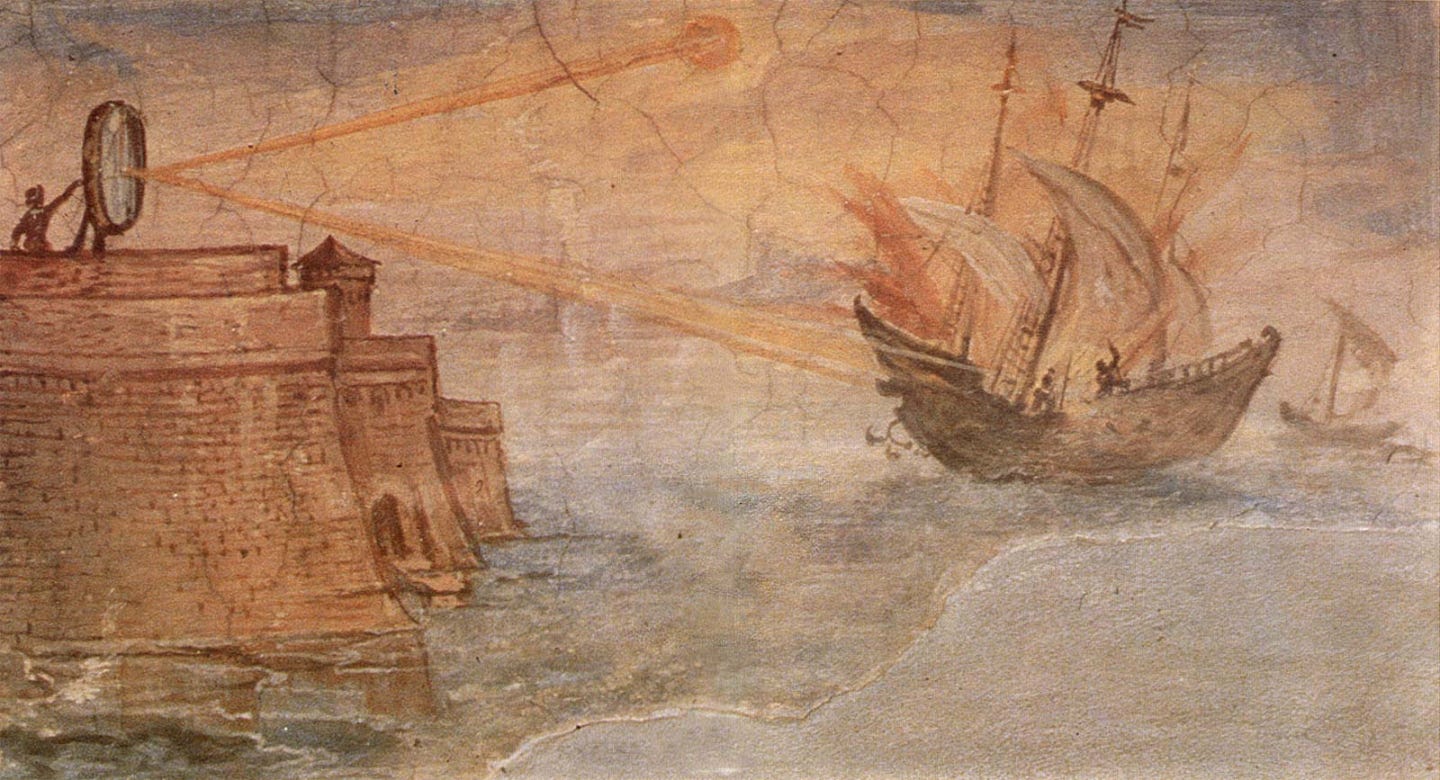
Syracuse’s role in history continued into the Christian era with a visit by St. Paul (Acts 28:12), who may have established one of the world’s first churches in the world in the city’s labyrinthine catacombs. Two centuries later, St. Lucy was martyred in the city and a depiction of her burial still hangs in her church, in the exact spot its creator, Baroque painter Caravaggio, envisioned.
I intend to follow in the documented footsteps of these historical events and their narrators. I will create audio guides for visitors to the city to listen to while they explore the city to bring history to life, and enhance their present experience in the city. The exact form this media will take will become clearer as time goes on, although I’m excited to explore the many ideas I have.
Of course, I recognize most won’t be able to visit Syracuse to take full advantage of these resources. I’m anticipating the creation of plenty of written, podcast, and photographic material for the geographically disinclined as well.
These resources will be buoyed by the knowledge of how this information has, against all the odds, bobbed and weaved its way through the millennia to reach us today. All those names I marked down in bold left memories of history, but the actual hands who copied down and preserved those texts are largely from the much later Byzantine Empire, of which Syracuse served as capital for a few years.
If you’re interested in a broad history of these millennia and the innovations which carried these ancient texts to us, check out my Greek Transmission Series.
Buon Viaggio!
If you can’t tell already, this is an ambitious project for one person. I’ll have only a limited time in each location, and will be trying out new forms of media creation at the same time. Of course, I also want to have time to enjoy myself!
Still, I can’t wait to take a crack at this expanded genre of production and see what I enjoy (or not) and what I feel proficient enough at (or deficient).
In the meantime, I’m just a few sign-ups away from 100 subscribers. Hitting 100 subscribers would be a perfect achievement to kick off this new phase of Culture Cross and show that I’m moving in the right direction. The number of new subscribers has slowed down significantly this year, and I spend most of my time focusing on research and content, rather than spreading the word (which I do a bit of on Substack Notes if you’d like to follow me there). If you’re able to show your support with a subscription, a share to your networks, a like, or a comment, that would mean the world to me as I try and share a world with all of you.
All my essays on this site are free, and I intend for whatever I create as a result of this trip to Italy to be free, too. After all, I am doing this as much for my own personal development as for any other reason. But it’s always encouraging to receive support.
If you have any questions or suggestions, please leave a comment below!
-James




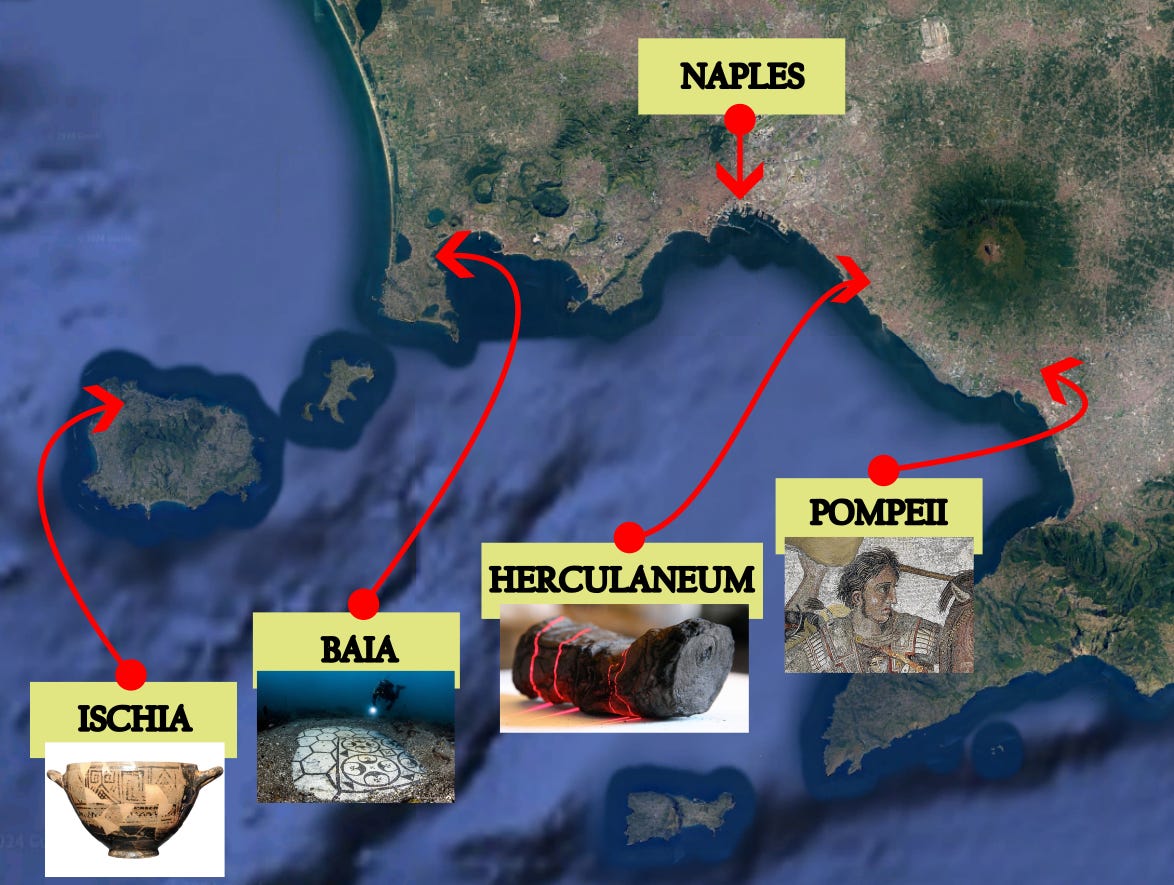





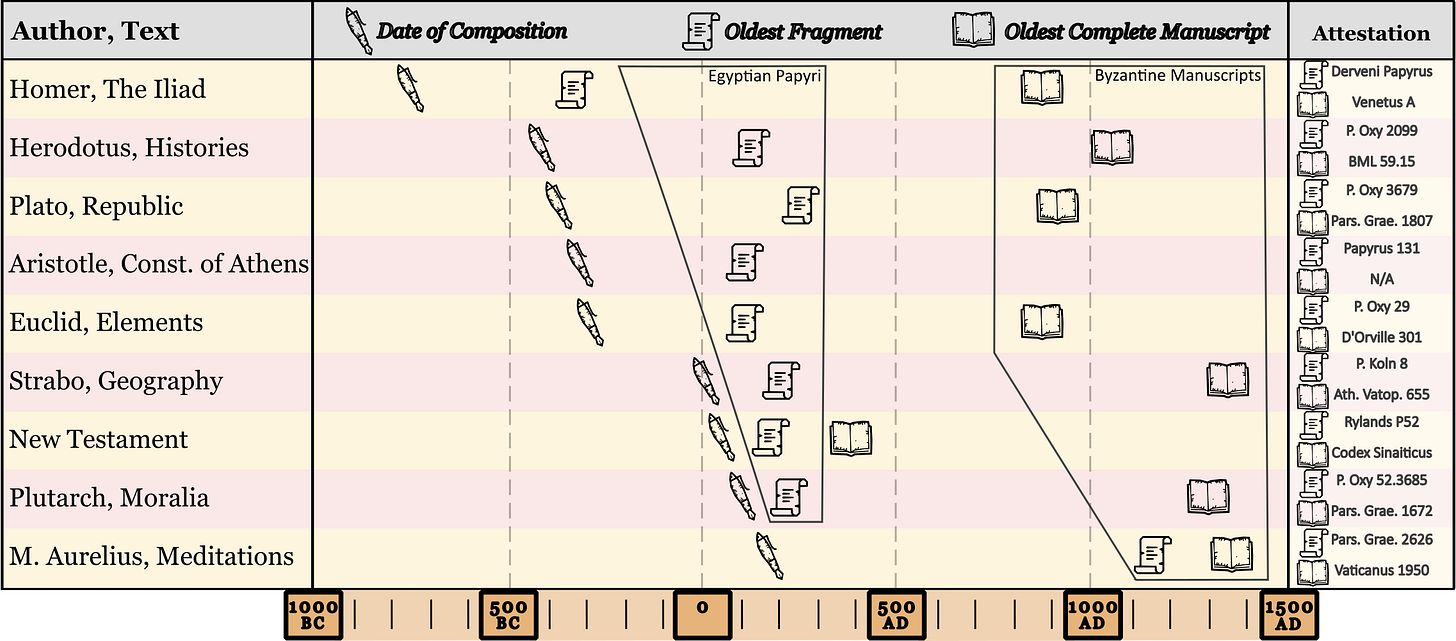

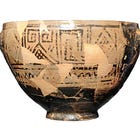
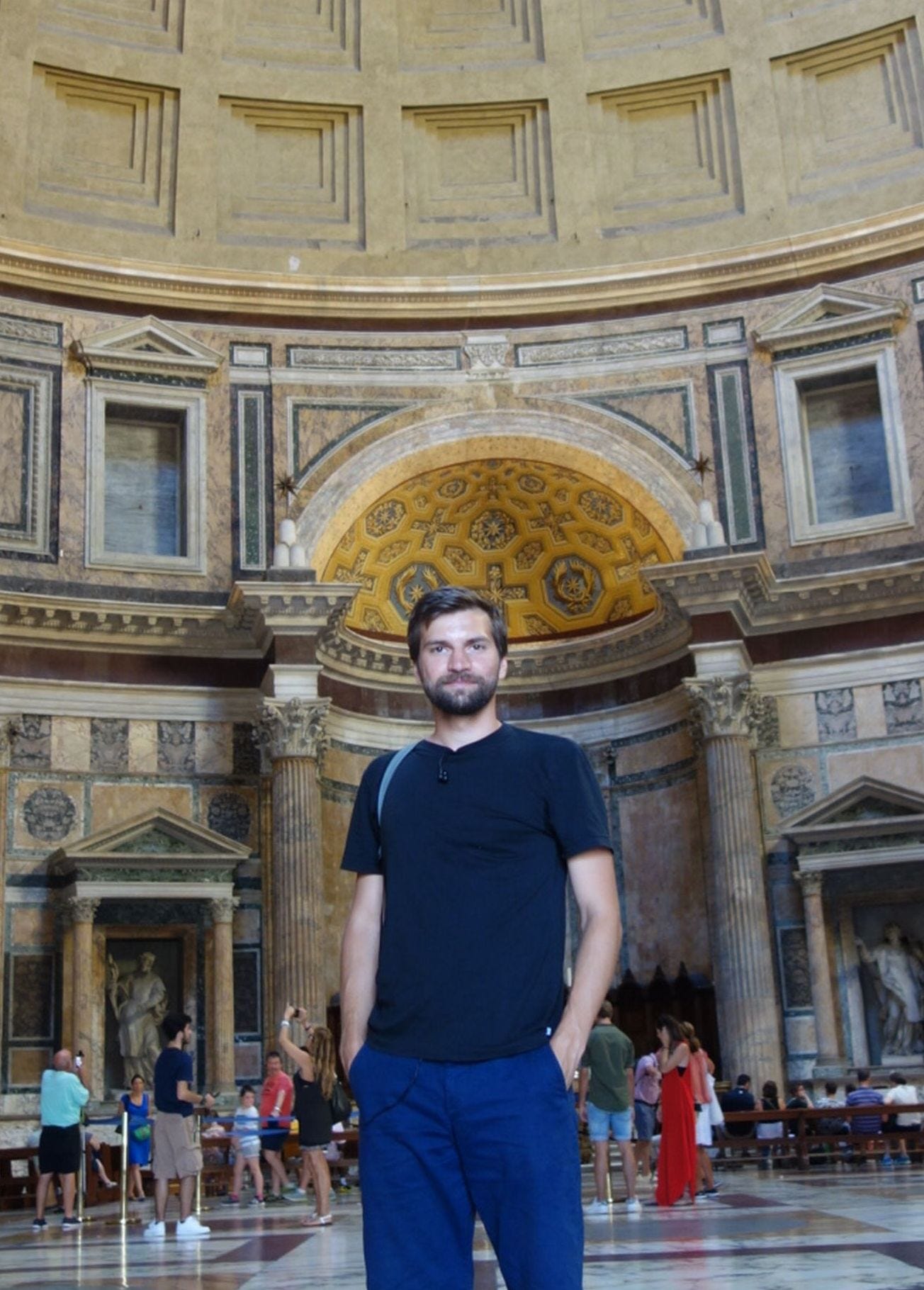

Sounds like a great trip and I look forward to reading and seeing your upcoming adventures. My minor in University decades ago was in history (medieval cities, ancient astronomy) and I love your work. Safe travels!
Diving in Baia! How cool. That and the impression the theatre festival made on you ("vitality of an ancient tradition") – those things evoke awe and a sense of adventure and I adore that.
Also love the ambition to take it beyond the online written word and to embodied experiences. Curious to see how it unfolds for you :)
I'm sure you'll have a great time in Italy. Good luck with your creative research endeavours too!